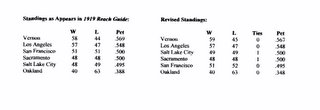The 1918 Season Recompiled
The 1918 Season Recompiled
That brings us to 1918, the season where the Coast League threw in the towel at mid-season. In the Coast League Cyclopedia, we used the pitching records as compiled by Robert C. Hoie, of
Last year we decided to compile the batting side of the 1918 season. We felt that there was a good chance— considering that only individual batting stats made it to print— that those batting statistics had been sloppily compiled. At the same time we compiled our batting stats, we compiled pitching stats in order to see that runs and hits made by batters matched runs and hits allowed by the pitchers. We expected some minor discrepancies between our compilation and the Robert C. Hoie compilation, and a great number between our batting stats and the batting record published the following spring in the baseball guides.
Again, we couldn’t have been further off the mark! As it turned out, we found relatively few discrepancies with our compilation and that of the league statistician on the batting side of the equation. With Mr. Hoie, it was quite a different matter. In the four categories (games pitched, games started, complete games, shutouts) where it’s virtually impossible for one box score to differ from another, we found fully 20% of pitchers’ records in the league to be in error in the Hoie compilation. And, overall, we found 119 “discrepancies,” many of which we believe cannot be explained away by the use of different box scores.
To give the reader some idea of what we call “discrepancies,” we will give the details on three that we find instructive:
1) While Mr. Hoie lists Hi West with 78 strikeouts, we were only able to find 28. While a strikeout or two might be explained away by a different source newspaper, fifty seems to be somewhat beyond that type of explanation.
2) Mr. Hoie credits Jack Picus Quinn with 13 victories, yet Quinn pitched complete games in 14 contests where his team scored the most runs. And in five of those contests (on April 9, May 15, June 16, June 26, and July 9), the opponents did not score, which— according to Mr. Hoie— gave pitcher Quinn four shutouts! (Additionally, it did not apparently change the win-loss record of the pitchers he opposed. Another perplexing turn of events.) We checked every one of Quinn’s games pitched in the following papers: San Francisco Chronicle,
3) Spider Baum is one of the great PCL— and minor league— pitchers of all time. Mr. Hoie lists Baum with 7 losses. We have 8. In five of those losses, Baum was the only
While Mr. Hoie might be a fine historian— though we have found only two articles with his name on them— it appears to be nothing more than a dilettante when it comes to compiling league averages. The point being: It’s not that easy to compile averages from box scores, and— by extension— a book like this, with more than a half-million pieces of data is bound to have its share of errors, though we have made every effort to keep them to a minimum. And so we ask an reader who finds any possible error to contact us. After all, they are still making corrections to the major league record in the encyclopedias some thirty-five years after the first Macmillan Baseball Encyclopedia came out.
One additional note on 1918: In compiling our pitching averages, we came across several games where earned runs (called runs responsible for by the PCL) did not appear in any of the box scores we consulted. What we did was use the weekly pitching stats issued by the league, and published in several papers around the league every Tuesday, that gave wins, losses, and runs responsible for to determine earned runs for the few games in which they were missing. When we didn’t have the RRFs for a game, we subtracted what we had for each pitcher involved in the game from the weekly RRF totals. In no case was the pitcher involved in more than one “missing RRF game” during the week in question.
Our 1918 standings are also at variance with the official published record, as indicated below:

We believe the following will demonstrate why the published league standings are in error:
By 1918 standings were carried on a daily basis in most— if not all— the newspapers in league cities. Therefore, we immediately knew the date when the errors took place. With the standings issued after games played on Sunday, June 9, we found the one of Vernon’s two wins over Sacramento and San Francisco’s loss at Salt Lake were not counted for some reason in the four papers consulted (SF Chronicle, SF Examiner, Sacramento Bee, LA Times). After games played on July 13, the LA Times listed the
At the league meetings that winter, the 1918 season had been long forgotten, and the owners only concentrated on the coming 1919 season, and the expansion of the league to eight clubs. We found no discussion of protested games, or even about compiling pitching stats to go with the batting stats that were issued by the league on a weekly basis during the season. No pitching averages were ever issued, so we believe that was the reason those games were never picked up by the league statistician. Had the league statistician— who did such a marvelous job on the batting— finished compiling the pitching statistics, we believe the standings would have been found to be in error and corrected, especially since the official batting statistics apparently included those games.

0 Comments:
Post a Comment
<< Home